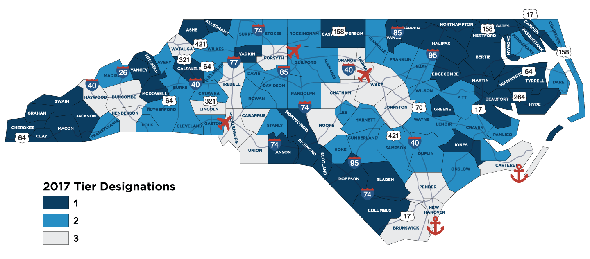What’s the Deal with the NC Tier System?
September 11, 2017

Companies looking to expand in, or into, NC will eventually learn that the sites they are investigating are in either Tier One, Tier Two or Tier Three counties. What do those designations mean and why are they important?
For some time, the NC Legislature and the NC Department of Commerce have sorted our state’s one hundred counties into three groups, which they call ‘Tiers’. Each Tier indicates an assessment of the local economy across a number of measures. There are twenty Tier Three counties, which comprise the most prosperous areas of the state. The remaining counties are divided into two groups of forty - Tier Two and Tier One.
While the criteria have changed a bit over time, the Tier system balances the following four indicators:
- Average unemployment rate
- Median household income
- Percentage growth in population
- An adjusted property tax base per capita
Each year the criteria are re-analyzed, and counties move in and out of the various Tiers.
This system isn’t perfect, but it has proven to be a good way to measure the relative health of a county’s economy. It’s purpose is to allow the state to direct resources appropriately where they may be needed most.
Before discussing those resources, there are three important characteristics of the Tier system that one should note. First, since the system combines four different measures, the Tier designation doesn’t tell you anything about any one measure. Each county will have a different mix. There can be - indeed there is - a lot of variability within each Tier. Second, you’ll note the Tiers are relative designations. The counties are sorted into three groups of predetermined size; the scores are not used to determine how many counties should be in each Tier. That means they are used as a general guide rather than a precise description. Finally, every county across the state has a lot of variability of economic vibrancy within its borders. A Tier designation is a marker, but it doesn’t really describe what’s under the hood.
There’s also one misunderstanding that should be cleared up. Being a Tier Three county doesn’t necessarily make that area the right place to locate a particular business. Similarly, being a Tier One county isn’t the wrong place. It just means the areas are different. Depending on a business’ needs, one area or the other may be the best fit.
What the Tiers do mean, however, is the economic resources provided by the state differ greatly. Tiers are relative measures of a local economy’s prosperity. We want all areas across the state to be as prosperous as they can be. So, assistance offered to counties increases from Tier Three to Tier One. That can be very helpful to businesses looking to grow.
For example, large projects in North Carolina may be eligible for Job Development Investment Grants (JDIG) if they create enough jobs at high enough wages. JDIG incentives work differently in different Tiers. Fewer jobs with somewhat lower minimum average wages are required in Tier One counties than in Tier Two or Tier Three counties. The same is true for another incentive program called One North Carolina Fund (One NC).
Likewise, the several programs available to fund public infrastructure associated with economic development, or to renovate vacant industrial and commercial buildings are also skewed to Tier One and Two counties. In fact, other state agencies which are not involved with economic development use the Tier system to allocate their program resources.
Your economic development professional will sort through everything available to help your decision.
The Tier system should neither be seen as a mystery, nor a judgment. It’s simply a way for a very engaged state government to organize its services appropriately. Most times, a county’s Tier designation won’t matter much to a prospective business, unless it qualifies for incentives or assistance. Then it can be a very good thing.
Mark Zimmerman owns a real estate brokerage and was appointed for a four year term to the EDPNC Board of Directors in 2016.
ADD ITEM TO REPORT
As you navigate our website, you can use the “Add Item to Report” button to add any page or property to a custom report that you can print out or save.

